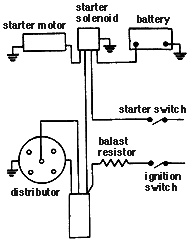 NOTE: The following discussions were taken from the Chicagoland MG Club Technical Tip library.
NOTE: The following discussions were taken from the Chicagoland MG Club Technical Tip library.
Ignition Timing
http://www.chicagolandmgclub.com/techtips/general/570.html
After checking the ignition system, ensure the ignition timing is in accordance with the manufacturers' recommendations. Two suitable methods are shown:
 a. Static Ignition Timing a. Static Ignition Timing
 b. Stroboscopic Timing b. Stroboscopic Timing
Static Ignition Timing
 Rotate the engine until No. 1 piston is just before TDC on the compression stroke. At this point, the rotor arm should be pointing to the distributor cap segment connected to No. 1 spark plug. The contact breaker points should be just at the point of opening in the direction of rotation. This can be verified by connecting a voltmeter between the distributor LT terminal and a good earth. At the precise moment the contacts open, the voltmeter will register battery voltage. Should the ignition timing be incorrect, centralize the micrometer adjuster (if fitted), slacken the distributor clamp bolt and position the distributor to the point of contacts about to open and re-tighten clamp bolt. Rotate the engine until No. 1 piston is just before TDC on the compression stroke. At this point, the rotor arm should be pointing to the distributor cap segment connected to No. 1 spark plug. The contact breaker points should be just at the point of opening in the direction of rotation. This can be verified by connecting a voltmeter between the distributor LT terminal and a good earth. At the precise moment the contacts open, the voltmeter will register battery voltage. Should the ignition timing be incorrect, centralize the micrometer adjuster (if fitted), slacken the distributor clamp bolt and position the distributor to the point of contacts about to open and re-tighten clamp bolt.
 It must be remembered an incorrect contact gap can affect ignition timing. The contacts must be set and maintained at 0.35-0.40 mm (.014"-.016") . It must be remembered an incorrect contact gap can affect ignition timing. The contacts must be set and maintained at 0.35-0.40 mm (.014"-.016") .
 The ignition timing is now set with sufficient accuracy to be able to start and run the engine. Final adjustment may be carried out using the stroboscopic timing light and micrometer adjustment. The ignition timing is now set with sufficient accuracy to be able to start and run the engine. Final adjustment may be carried out using the stroboscopic timing light and micrometer adjustment.
Stroboscopic Timing
 Connect the strobe HT pick-up into No.1 plug lead and disconnect the distributor vacuum pipe. In the case of a separate strobe, battery supply will also be required. Connect the strobe HT pick-up into No.1 plug lead and disconnect the distributor vacuum pipe. In the case of a separate strobe, battery supply will also be required.
 Start and run the engine at the manufacturers' specified idling speed. Direct the strobe light on the timing marks and check the degrees of advance against the recommended figures. Start and run the engine at the manufacturers' specified idling speed. Direct the strobe light on the timing marks and check the degrees of advance against the recommended figures.
 The strobe light can also be used to check that the centrifugal and vacuum advance mechanisms are operating, but in order to do this, the figures obtained must be compared to those specified to the particular vehicle. The strobe light can also be used to check that the centrifugal and vacuum advance mechanisms are operating, but in order to do this, the figures obtained must be compared to those specified to the particular vehicle.
Ballast Resistor Ignition System
http://www.chicagolandmgclub.com/techtips/general/587.html
 Conventional ignition coils suffer the disadvantage of being designed to operate best at about 12 volts. Unfortunately, a 12 volt battery often produces as little as 7 volts when "run down" because of excess starter operation, especially in extreme cold. To produce optimum coil performance (and hence nice fat sparks at the spark plugs) under such adverse conditions, the "ballast resistor" or "ballasted coil" system was developed.
Conventional ignition coils suffer the disadvantage of being designed to operate best at about 12 volts. Unfortunately, a 12 volt battery often produces as little as 7 volts when "run down" because of excess starter operation, especially in extreme cold. To produce optimum coil performance (and hence nice fat sparks at the spark plugs) under such adverse conditions, the "ballast resistor" or "ballasted coil" system was developed.
This system uses a coil which is designed to be most efficient at about 8 volts. For starting, full battery voltage is supplied! This makes this system as efficient at low battery voltage as a "conventional" coil is with the battery supplying a full 12 volts. (For any battery voltage above the coil's design voltage, it's even better - an "overboost" condition.) However, an eight volt coil cannot be run continuously at 12 volts without overheating and failing. As soon as the starter switch is released, the coil no longer receives full battery voltage. It is then powered through the ballast resistor which reduces the 12 volts (the generating system is now working) to the coil's design voltage.
|